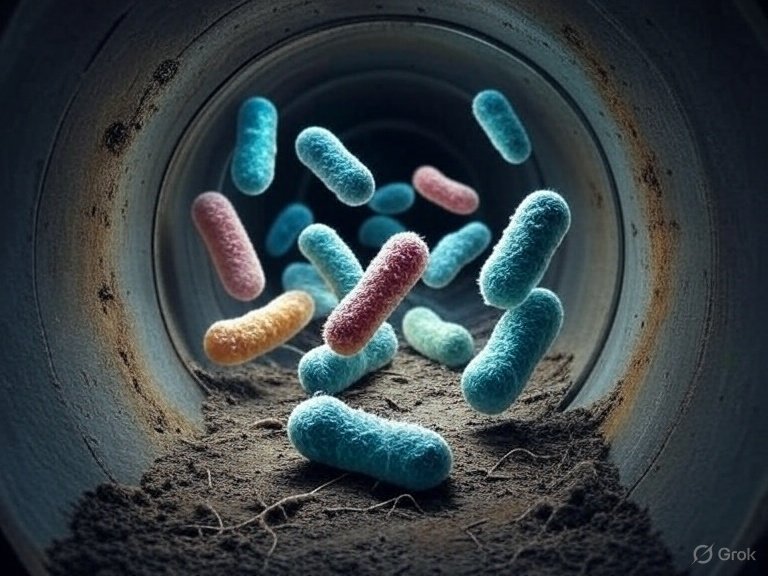
Hydrogen sulfide (H2S) is a toxic, corrosive gas posing significant challenges in the oil and gas industry. Its presence in reservoirs, pipelines, and processing facilities can compromise infrastructure integrity, degrade product quality, and endanger worker safety. A primary source of H2S is bacterial activity, particularly from sulfate-reducing bacteria (SRB). This article explores the mechanisms by which bacteria produce H2S, conditions promoting its formation, and its effects on asset integrity, product quality, safety, and operational efficiency. It also discusses mitigation strategies.
Mechanisms of Bacterial H2S Production
Sulfate-Reducing Bacteria (SRB) and Their Role
Sulfate-reducing bacteria are anaerobic microorganisms thriving in oxygen-deprived environments like oil reservoirs, pipelines, and water injection systems. SRB use sulfate (SO42-) as an electron acceptor, reducing it to sulfide (S2-), which forms H2S with hydrogen ions. The reaction is:
SO42- + 8H+ + 8e– → S2- + 4H2O
This process, dissimilatory sulfate reduction, relies on organic compounds (e.g., acetate) or hydrocarbons as electron donors. In oilfields, SRB metabolize organic compounds in formation water or introduced during operations.
Conditions Favoring SRB Activity
SRB flourish under specific conditions common in oil and gas systems:
- Anaerobic Environments: SRB require low or no oxygen, prevalent in deep reservoirs or stagnant pipelines.
- Temperature Range: Mesophilic SRB thrive between 25°C and 40°C; thermophilic SRB survive up to 80°C.
- pH Levels: SRB prefer neutral to slightly acidic conditions (pH 6–8).
- Nutrient Availability: Sulfate, organic carbon, and trace elements like nitrogen are essential.
- Salinity: SRB tolerate a range from freshwater to hypersaline brines.
Other Microbial Contributors
While SRB are primary H2S producers, sulfur-reducing bacteria and archaea can reduce elemental sulfur or thiosulfate to H2S, though their impact is less significant.
Reservoir Souring
Reservoir souring occurs when H2S concentrations increase in reservoirs, often due to water flooding with seawater introducing sulfate and nutrients, stimulating SRB. H2S partitions across oil, gas, and water phases, spreading through the system.
Effects of H2S in the Oil and Gas Industry
H2S from bacterial activity impacts infrastructure, product quality, safety, and environmental compliance.
1. Asset Integrity and Corrosion
H2S is highly corrosive, especially with water, damaging infrastructure:
- Microbiologically Influenced Corrosion (MIC): SRB biofilms create anaerobic zones on metal surfaces. H2S reacts with iron to form iron sulfide (FeS), accelerating pitting corrosion, which can cause rapid pipeline or casing failure.
- Fe2+ + S2- → FeS
- Sulfide Stress Cracking (SSC): H2S causes embrittlement of high-strength steels, leading to cracking under stress, critical for downhole equipment.
- General Corrosion: H2S dissociates into HS– and S2- in water, promoting electrochemical corrosion.
Corrosion increases maintenance costs, downtime, and risks of leaks or spills.
2. Product Quality Degradation
H2S contamination affects oil and gas marketability:
- Sour Crude and Gas: High H2S content classifies products as “sour,” reducing value due to extra processing. Refineries limit H2S to <10 ppm for gas and <100 ppm for crude.
- Reduced Refinery Efficiency: H2S poisons catalysts, lowering yields.
- Odor and Specifications: H2S causes foul odors and may lead to product rejection for failing pipeline specifications.
3. Health and Safety Risks
H2S is highly toxic:
- Toxicity: At 10–50 ppm, H2S causes irritation; above 100 ppm, it can cause unconsciousness or death. Its desensitizing effect on smell makes it dangerous.
- Operational Safety: H2S requires gas monitoring, PPE, and emergency plans, increasing costs.
4. Environmental Impact
H2S releases have environmental consequences:
- Air Pollution: H2S combustion produces sulfur dioxide (SO2), contributing to acid rain.
- Regulatory Compliance: Strict H2S emission limits lead to fines or restrictions if violated.
- Ecosystem Damage: H2S leaks harm aquatic life and vegetation.
5. Operational and Economic Consequences
H2S increases costs:
- Treatment Costs: H2S removal using scavengers or amine units is expensive.
- Downtime and Maintenance: Corrosion repairs reduce profitability.
- Insurance and Liability: High H2S levels raise premiums and risks.
Mitigation Strategies
Managing H2S requires preventive and corrective measures.
1. Preventive Measures
- Biocide Treatments: Glutaraldehyde or quaternary ammonium compounds kill SRB, though resistance may develop.
- Nitrate Injection: Nitrate promotes nitrate-reducing bacteria, outcompeting SRB, an eco-friendly approach.
- Water Management: Using low-sulfate water or treating produced water limits SRB growth.
- Material Selection: Corrosion-resistant alloys or coatings reduce H2S damage.
2. Corrective Measures
- H2S Scavenging: Triazine neutralizes H2S, forming non-corrosive byproducts.
- Gas Sweetening: Amine units remove H2S, producing sulfur via the Claus process.
- Monitoring and Maintenance: Ultrasonic testing and H2S sensors detect issues early.
3. Emerging Technologies
- Microbial Management: Metagenomics profiles microbial communities for targeted interventions.
- Nanotechnology: Antimicrobial nanoparticles inhibit SRB biofilms.
- Electrochemical Methods: Cathodic protection reduces corrosion.
Conclusion
Bacterial H2S production, primarily by SRB, is a pervasive issue in the oil and gas industry. Its corrosive, toxic, and quality-degrading effects necessitate robust management. By understanding H2S formation and implementing preventive and corrective measures, operators can protect infrastructure, ensure product quality, and safeguard health and the environment. Advances in microbial ecology, materials, and treatments promise improved management for safer, sustainable operations.




